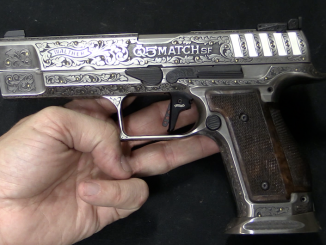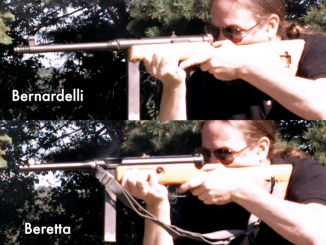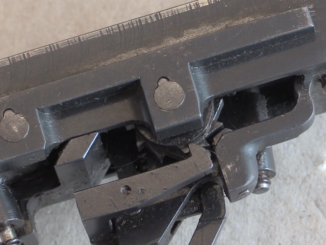The SITES Spectre was originally developed by the SITES company (Societa Italiana a Technologie Speciali SPA) of Torino to be the best police and counterterrorist submachine gun on the market. To this end, they studied the other guns on the market and what made a good SMG. The results were rolled into the Spectre design – things like minimal width (about 35mm), no protrusions to the sides, ambidextrous controls, closed-bolt operation, quad-stack magazines, and a double action trigger option in place of a traditional manual safety. The gun went into production in 1985 as the Model 2…but did not garner many sales.
It was shortly updated to the Model 4 with improved sights and stock, and better disassembly procedure. It was also released as a semiautomatic pistol and carbine, in an effort to create some cash flow on the civilian market. The standard version was in 9x19mm, but it was also sold in .40 S&W, 9×21 IMI, and .45 ACP. Importation into the US lasted until 1993, and the guns were never all that popular. As a submachine gun it was a fine design, but simply not better enough than its competition to bring sales in a market crowded with other options. As a semiautomatic pistol, it was heavy and awkward (6.4 pounds / 2.9kg unloaded). SITES went out of business in 1997 and the rights were purchased by Swiss company Greco Sport. They continued to manufacture them until 2001, and went out of business themselves in 2006.




Unfortunately we still are restricted from using 9×19 on handguns (but allowed on long guns!).
Magazine aside, probably one of the cheapest closed bolt submachineguns to manufacture.
Guessing from what I see it is also a bit over-built. That sheet metal on receiver looks like 2mm thick (assuming steel). It probably would do well with something like 1,5mm. Even AK47/74 receiver is just 1mm thick.
It is an italian production from the 80s, it HAS to be overbuilt 😀
Jokes aside, if i remember it correctly from old magazines, the steel thickness came from sourcing the material and tooling among the cheapest available to the shared automotive/train carriage industry, which populated the area around Torino, where SITES was based. This was in contrast to traditional italian firearms firms, which clustered around Brescia, worked on different standards and supply chain.
The B&T GHM9, https://www.bt-ag.ch/shop/eng/bt-ghm9-2/bt-semi-automatic-carbine-ghm9-cal-9-x-19-mm , albeit more accessorized, weights less than the original being able to, as you pointed out, save on reciever thickness.
Actually, I remember Fiat cars from 60s and 70s, they were light and well optimized. But then something like Guzzi motorbikes is quite different case – robust with generous amount of metal everywhere. I guess it depends on particular case.
Anyway, as you mentioned the B&T iteration is in their typical direction, that is extruded aluminum channel with mounted blocks/ trunions held with countersunk screws. It looks kind of crude at first glance from traditional arms-making point of view, but technically and economically it makes sense.
I also noticed that they added to GHM9 couple of new functions, such as bolt hold open button. They are surely smart guys. This is in addition to what was already pretty clever design out of original maker.
@Denny
Yeah, but AK receiver is fully heat treated; all stamped smg receivers are, as far as I know, mild steel.
That’s why they had a milled receiver phase – probably could not get the heat treating and stamping right in the first version.
Also I dont know if there are some differences in boxlike shape of receiver that is heat treated and like in AK, U shaped which is simpler.
New modern manufacturing as in B&T seems to prefer using aluminum, and even more- plastic (yuck- dont like toyish feel of the guns).
Surprisingly I feel sorry for the gun. And just how would it get noticed when other big brands have a significantly bigger share of the gun market?
I would say, such name choice (Spectre) might be not most fortunate. Is not spectre associated with spooky?
It probably has to do with NOCS, its main customer, whose motto is “Sicut Nox Silentes” (As Silent as the Night).
Doesn’t B&T make an updated version of it now?
No. What you have in mind is Steyr machine-pistol with rotary barrel and magazine in grip labeled in BT catalogue as MP9/TP9. But even that one is not selling very well and it fell into second row after new genuine BT universal service weapon.
The have also weapon named APC9: https://www.bt-ag.ch/shop/eng/bt-apc9apc45/bt-smg-apc9-cal-9-x-19-mm-2
The TP9 is actually pertinent comparison piece. Here is MAC raving about his own presumably legally tricked up weapon. Of course TP9 is all in plastic housing which traces Spectre by couple of years.
https://www.youtube.com/watch?v=f0UmxKqnRwg
MAC has also video on Spectre in both original form and modified by B&T:
https://www.youtube.com/watch?v=sqa1BQZYeYo
He’s got apparently access to lots of stores thru his acquaintances in business.
No, he’s correct. It’s called the B&T KH9. It’s basically a modernized SITES Spectre.
Ok, I probably misread his original note.
“.40 S&W”
.40 S&W sub-machine gun? How such weapon compares with 9×19 sub-machine gun?
This is uncharacteristically ugly looking product for being of Italian origin. But, as Ian points out it has plenty of hidden sophistication. Yeah, it cannot be worn at belt, a major obstacle to standard police equipment. From what I read, it was used by undercover police with shot in chamber. Then, the double action trigger would make it ready for action, even from under the clothing.
Good show of up to now missing piece in long display of interesting and defunct designs.
Those who were kids or teenager in the 90s will remember the Frigate level of a certain Rare game…
You just had to bring up that game. I recall that the program involves a hit scan, where bullets go to the exact spot where you aim. The weakness of this can be seen when you fire a tank shell at any enemy who’s running behind a rock. Somehow the shell curves around the rock and chases your intended victim in the split second just before exploding and sending him to his inevitable death. I could be wrong.
I did not went that far in glitch exploiting…
Thank you for sharing !
Does anyone know if any full auto versions made it into the US NFA registry before 1986? I have never seen one in full auto
First: Thanks for the, as usual, very good video.
But . . . it seems there went something wrong with the history. You stated in the video, there would have been no demand for the gun. I remember well, when the SITES was first introduced. It was developed on demand and with the assistance of Italian and German police, who had found that, the otherwise excellent, MP5 and M12S had, in case of a surprise attack, a too long response time, as incidents with Mafia, Red Brigades and the Red Army Fraction had shown. So the SMG was welcomed as the best since sliced bread, ideal as prime weapon for body- and security guards. I still wonder, why it then dropped off the radar.
I had hoped to find the answer here, but, as it seems, there must be still a lost part of the puzzle.
It was found employed along Beretta 93Rs.
Reasons given for its demise here in Italy include:
– magazine issues;
– Beretta and Hk competition: MP9k and sd were easily available on one side of the spectrum, and PM12 was still plenty satisfactory and cheap on the other;
– Too niche role, and too small orders;
– Which leads to the main culprit, a faulty business model, as the company could not substain itself on a single product, even if cheap to produce, as it could not apply any economy of scale with no (viable) civilian market or large military contract.
Whoever owned (or owns) the design probably made more money out of it licensing it to media.
You mentioned magazine issues. I take that the quad column magazines were not entirely reliable?
Indeed, very sensitive to foreign agents (that little roller…), and as Ian pointed out, tricky to load. Being single fed did not help much.
Even the SOCIMI 821 performed better!
As with many other designs, I think machine gun ban of 1986 killed it commercially.
Just look at the number of patents in the late 70s and 80s on smgs, and afterwards, and you will see what changed.
Its tricky to get a state contract, but selling on open civilian market will always found a customer, no matter how hard is the magazine to load, etc.
I remember getting to handle one of these for just a few moments at an LE vendor show sometime in the very late 80’s. It was set up as a short-barreled 9mm carbine, don’t remember if it was semi-auto-only or select fire. As a young rookie officer I was very impressed at the time, especially compared to the hodge-podge assortment of surplus Reising guns, M-1 carbines and occasional lever-action rifle my agency was using at the time. We were in the process of moving from revolvers to semi-auto pistols, so there was no money for long guns. Knowing what I now know about the reliability of the quad-stack mags, probably just as well.
“I have already made a quick search in the patents (US4469006 [https://docs.google.com/viewer?url=patentimages.storage.googleapis.com/pdfs/US4469006.pdf]; US4589218 [https://docs.google.com/viewer?url=patentimages.storage.googleapis.com/pdfs/US4589218.pdf]): there is not a single word about cool(ing), heat, shroud in these.
Hint: as we can see, the receiver and the barrel shroud is one part, maybe made from closed profile. The bolt fits almost perfectly in the profile, and acts as a piston: it sucks and presses air through the bore of the barrel and the openings of the barrel shroud during its movement.”
I think its a marketing gimmick, or some misunderstanding maybe back from the 80s, from some gun magazine review possibly,
that stuck on the internet and gets copy pasted without credibility.
Certainly H profile bolt is not fitting perfectly in stamped receiver (there is a reason why hydraulic pumps are round),
at least not one that would not be jammed with slightest amount of grit.
Anybody knows, how is the barrel removed ?